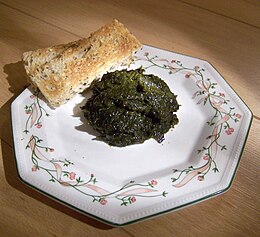
Laverbread (/ˈleɪvər-, ˈlɑːvər-/; Welsh: bara lafwr or bara lawr; Irish: sleabhac) is a food product made from laver, an edible seaweed (littoral alga) consumed mainly in Wales as part of local traditional cuisine. The seaweed is commonly found around the west coast of Great Britain, and the coasts of Ireland, where it is known as sleabhac.[1] It is smooth in texture and forms delicate, sheetlike thalli, often clinging to rocks. The principal variety is Porphyra umbilicalis, a red algae which tends to be a brownish colour, but boils down to a dark green pulp when prepared. Laver seaweed has a high content of dietary minerals, particularly iodine and iron. The high iodine content gives the seaweed a distinctive flavour in common with olives and oysters.
Laver seaweed has been cultivated as a food in Wales since at least the 17th century. It is prepared by repeated washings and then boiling until it becomes the soft purée-like product known as laverbread. The gelatinous paste that results can then be sold as it is or rolled in oatmeal. It is sometimes also coated with oatmeal prior to frying. Laverbread is traditionally eaten fried with bacon and cockles as part of a Welsh breakfast or, in the southwest of England, with hog's pudding.
- ^ "Laver Seaweed – A Foraging Guide to Its Food, Medicine and Other Uses". eatweeds.co.uk. 30 August 2018. Retrieved 22 March 2021.
© MMXXIII Rich X Search. We shall prevail. All rights reserved. Rich X Search
